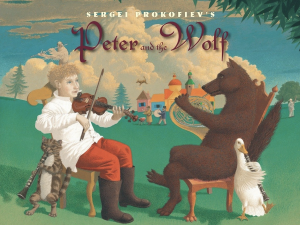Story Time at the Symphony
Words by Kate Hamori
One of my most vivid musical memories is from my very first orchestra rehearsal in high school. I won’t lie—I was totally panicking. But as soon as we started to play, all my thoughts and worries disappeared, not because of “the power of music” or anything cool or inspiring like that, but because my mind was flooded with memories of Bugs Bunny running circles around Elmer Fudd while brandishing a straight razor and a can of shaving cream.
Turns out that all of those early Saturday mornings spent watching Looney Tunes paid off! I may not have known the name of the piece or the composer, but it turns out that I was quite familiar with the music we were playing: it was the overture from Rossini’s opera The Barber of Seville.
Through a child’s eyes, the modern symphony orchestra can seem intimidating, inaccessible, and boring. But composers were finding ways to introduce children to classical music long before Bugs Bunny began snacking on carrots. Take, for example, the case of Peter and the Wolf.

Written in the summer of 1936, Sergei Prokofiev’s Peter and the Wolf is a symphonic fairy tale for orchestra and narrator. It tells the story of a young boy named Peter who lives in the woods with his grandfather. One day, Peter spies his pet cat stalking a bird and a duck. He quickly warns the woodland creatures of the feline predator and they narrowly escape his cat’s clutches. Soon after, Peter’s grandfather ushers him inside, scolding him for hanging out in the woods where a wolf might appear at any moment!
Indeed, later that very day, a sinister wolf appears in the clearing looking for its next meal. While the cat and bird manage to escape, the duck is not so fortunate. In an attempt to save his remaining animal friends, Peter grabs a rope and climbs a tree. He then sends the bird to distract the wolf while he sneakily loops the rope around the wolf’s tail from above and traps the predator! A trumpet call announces the arrival of a group of hunters brandishing rifles, but before they can harm the wolf, Peter convinces them to take it to a zoo instead, and the animals and humans alike victoriously escort the wolf to its new home.
In addition to its themes of kindness and bravery, Peter and the Wolf was designed to introduce young children to the sounds of the orchestra by personifying instruments as characters. Prokofiev’s detailed performance instructions indicate that the narrator of the piece should briefly introduce each character’s instrument and unique leitmotif prior to the performance. While the nature of the introduction varies with each performance, the cast list always remains the same:
The Bird—Flute
The Duck—Oboe
The Cat—Clarinet
The Grandfather—Bassoon
The Wolf—French horns
Peter—Strings
The Hunters’ Guns—Kettle and bass drums
Popular with adults and children alike, Peter and the Wolf has been performed by a host of major symphony orchestras with the help of some incredibly talented narrators such as David Tennant, Alice Cooper, Mikhail Gorbachev, Bill Clinton, Sophia Loren, Sharon Stone, David Attenborough, Sir Patrick Stewart, Itzhak Perlman, Leonard Bernstein, and, my personal favorite, David Bowie.
Fun, approachable, and irresistibly witty, Peter and the Wolf has quickly become one of my favorite orchestral pieces. In fact, I think I enjoy the piece even more now that I’m grown—for a brief half hour, I get a chance to embrace my inner child and escape into a fantasy land just like the ones I remember from Looney Tunes.







Leave a Reply